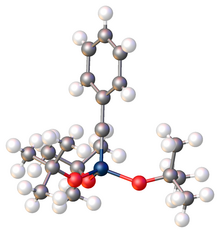Transition metal carbyne complexes are organometallic compounds with a triple bond between carbon and the transition metal.[1] This triple bond consists of a σ-bond and two π-bonds.[2] The HOMO of the carbyne ligand interacts with the LUMO of the metal to create the σ-bond. The two π-bonds are formed when the two HOMO orbitals of the metal back-donate to the LUMO of the carbyne. They are also called metal alkylidynes—the carbon is a carbyne ligand. Such compounds are useful in organic synthesis of alkynes and nitriles. They have been the focus on much fundamental research.[3]
Synthesis
Transition metal carbyne complexes are most common for the early transition metals, especially niobium, tantalum, molybdenum, tungsten, and rhenium. They can also have low-valence metals as well as high-valence metals.

The first Fischer carbyne complex was reported in 1973.[4] Two years later in 1975, the first "Schrock carbyne" was reported.[5]
Many high-valent carbyne complexes have since been prepared, often by dehydrohalogenation of carbene complexes. Alternatively, amino-substituted carbyne ligands sometimes form upon protonation of electron-rich isonitrile complexes. Similarly, O-protonation of μ3-CO ligands in clusters gives hydroxycarbyne complexes. Vinyl ligands have been shown to rearrange into carbyne ligands. Addition of electrophiles to vinylidene ligands also affords carbyne complexes.[3]
Bridging alkylidyne ligands in cluster compounds

Some metal carbynes dimerize to give dimetallacyclobutadienes. In these complexes, the carbyne ligand serves as a bridging ligand.
Several cluster-bound carbyne complexes are known, typically with CO ligands. These compounds do not feature MC triple bonds; instead the carbyne carbon is tetrahedral. Tricobalt derivatives are prepared by treating cobalt carbonyl with haloforms:[6]
- 2 HCBr3 + 9⁄2 Co2(CO)8 → 2 HCCo3(CO)9 + 18 CO + 3 CoBr2
Structure

Monomeric metal carbyne complexes exhibit fairly linear M–C–R linkages according to X-ray crystallography. The M–C distances are typically shorter than the M–C bonds found in metal carbenes. The bond angle is generally between 170° and 180°[8] Analogous to Fischer and Schrock carbenes; Fischer and Schrock carbynes are also known. Fischer carbynes usually have lower oxidation state metals and the ligands are π-accepting/electron-withdrawing ligands. Schrock carbynes on the other hand typically have higher oxidation state metals and electron-donating/anionic ligands. In a Fischer carbyne the C-carbyne exhibits electrophilic behavior while Schrock carbynes display nucleophilic reactivity on the carbyne carbon[9] Carbyne complexes have also been characterized by many methods including infrared Spectroscopy, Raman spectroscopy.[10] Bond lengths, bond angles and structures can be inferred from these and other analytical techniques.
Metal carbyne complexes also exhibit a large trans effect, where the ligand opposite the carbyne is typically labile.
Reactions and applications
Hexa(tert-butoxy)ditungsten(III) is a catalyst for alkyne metathesis.[11] The catalytic cycle involves an carbyne intermediate.[12]
Some carbyne complexes react with electrophiles at C-carbyne followed by association of the anion. The net reaction gives a transition metal carbene complex:
- LnM≡CR + HX → Ln(X)M=CHR
These complexes can also undergo photochemical reactions.
In some carbyne complexes, coupling of the carbyne ligand to a carbonyl is observed. Protonation of the carbyne carbon and conversion of the carbyne ligand into a π-allyl.[13]
Main group analogue
A sulfur-based main group analog of a carbyne complex has been prepared by Seppalt and coworkers.[14] The compound, trifluoro(2,2,2-trifluoroethylidyne)-λ6-sulfurane, F3C–C≡SF3, prepared by dehydrofluorination of F3C–CH=SF4 or F3C–CH2–SF5, is an unstable gas that readily undergoes dimerization to form trans-(CF3)(SF3)C=C(CF3)(SF3) at above –50 °C.
Further reading
- Mayr, A.; Bastos, C. M. (1992). Coupling Reactions of Terminal Two-Faced π Ligands and Related Cleavage Reactions. Progress in Inorganic Chemistry. Vol. 40. pp. 1–98. doi:10.1002/9780470166413.ch1. ISBN 9780470166413.
{{cite book}}:|journal=ignored (help)